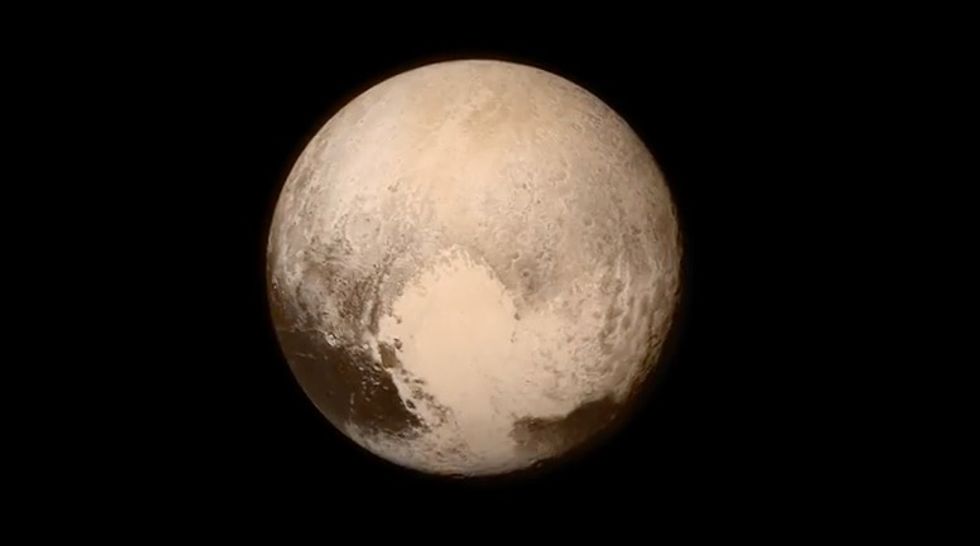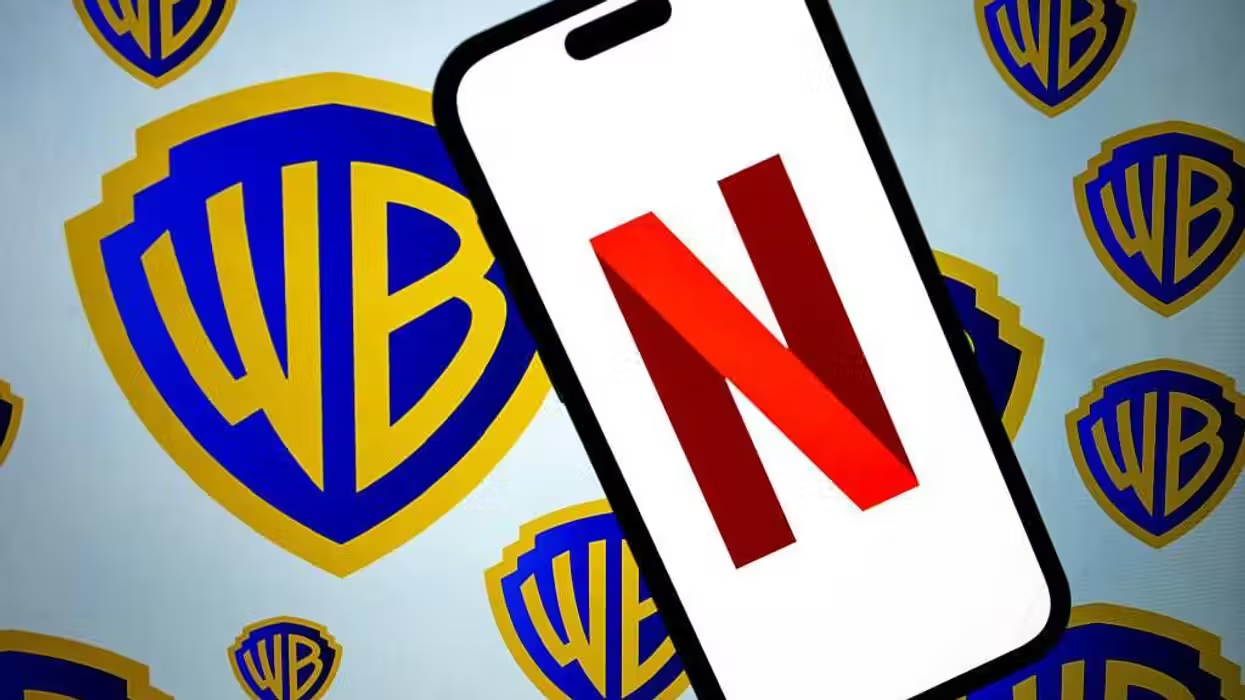
© 2026 Blaze Media LLC. All rights reserved.
This Is a Tremendous Moment in Human History': NASA Spacecraft Gets First Up-Close Look at Pluto
July 14, 2015
"What a phenomenal day."
CAPE CANAVERAL, Fla. (AP) — NASA's New Horizons spacecraft got humanity's first up-close look at Pluto on Tuesday, sending word of its triumph across 3 billion miles to scientists waiting breathlessly back home.
Confirmation of mission success came 13 hours after the actual flyby and, after a day of both jubilation and tension, allowed the New Horizons team to finally celebrate in full force.
"This is a tremendous moment in human history," John Grunsfeld, NASA's science mission chief, said at a news conference.
[sharequote align="center"]"This is a tremendous moment in human history."[/sharequote]
Principal scientist Alan Stern asked the entire New Horizons team in the audience to stand: "We did it! Take a bow!"
The unprecedented encounter was the last stop on NASA's grand tour of our solar system's planets over the past half-century. New Horizons' journey began 9½ years ago, back when Pluto was still considered a full-fledged planet.
Tuesday morning, a cheering, flag-waving celebration swept over the mission operations center in Maryland at the time of closest approach. But until New Horizons phoned home Tuesday night, there was no guarantee the spacecraft had buzzed the small, icy, faraway — but no longer unknown — world.
NASA said the spacecraft the size of a baby grand piano flew by within 7,700 miles of Pluto at 31,000 mph. It was programmed to then go past the dwarf planet and begin studying its far side.
To commemorate the moment of closest approach, scientists released the best picture yet of Pluto, taken on the eve of the flyby.
Even better images will start "raining" down on Earth beginning Wednesday, promised principal scientist Alan Stern. But he had cautioned everyone to "stay tuned" until New Horizons contacted home.
It takes 4½ hours for signals to travel one-way between New Horizons and Earth. The message went out late in the afternoon during a brief break in the spacecraft's data-gathering frenzy. The New Horizons team kept up a confirmation countdown, noting via Twitter when the signal should have passed the halfway point, then Jupiter's orbit.
The uncertainty added to the drama. "This is true exploration," cautioned Stern, a Southwest Research Institute planetary scientist.
Among the possible dangers: cosmic debris that could destroy the mission. But with the chances of a problem considered extremely low, scientists and hundreds of others assembled at Johns Hopkins University's Applied Physics Laboratory erupted in jubilation when closest approach occurred at 7:49 a.m. EDT. The lab is the spacecraft's developer and manager.
The scene repeated itself a little before 9 p.m. EDT.
This time, the flight control room was packed compared with earlier, when it was empty because New Horizons was out of touch and operating on autopilot.
"We have a healthy spacecraft," announced mission operations director Alice Bowman. She was drowned out by cheers and applause; Stern ran over to give her a hug.
Later, Grunsfeld told reporters, "The spacecraft is full of images. We can't wait. We've opened up a new realm of the solar system."
Added NASA Administrator Charles Bolden: "What a phenomenal day."
Joining in the daylong hoopla were the two children of the American astronomer who discovered Pluto in 1930, Clyde Tombaugh. (Some of his ashes are aboard the spacecraft.) Other celestial-minded VIPs included James Christy, discoverer of Pluto's big moon Charon, and Sylvia Kuiper des Tombe, daughter of Dutch-American Gerard Kuiper for whom the mysterious zone surrounding Pluto is named. Some Pluto children — born Jan. 19, 2006, the very day New Horizons departed Earth — also were in the audience.
Throughout the day — coincidentally the 50th anniversary of the first close-up pictures of Mars from Mariner 4 — the White House and Congress offered congratulations, and physicist Stephen Hawking was among the scientists weighing in. President Barack Obama sent his best Tuesday night with a tweet: "Pluto just had its first visitor!"
"Hey, people of the world! Are you paying attention?" planetary scientist Carolyn Porco, part of the New Horizons' imaging team, said on Twitter. "We have reached Pluto. We are exploring the hinterlands of the solar system. Rejoice!"
[sharequote align="right"]"To see Pluto be revealed just before our eyes, it's just fantastic."[/sharequote]
The U.S. is now the only nation to visit every planet in the solar system. Pluto was No. 9 in the lineup when New Horizons left Cape Canaveral, Florida, but was demoted seven months later to dwarf status.
Scientists in charge of the $720 million mission hope the new observations will restore Pluto's honor.
Stern and other so-called plutophiles posed for the cameras giving nine-fingers-up "Pluto Salute." And in a nod to that other Pluto, a team member carried a yellow stuffed dog on her shoulder Tuesday night.
The picture of Pluto taken Monday showed a frozen, pockmarked world, peach-colored with a heart-shaped bright spot and darker areas around the equator. It drew oohs and aahs.
"To see Pluto be revealed just before our eyes, it's just fantastic," said Bowman.
The Hubble Space Telescope had offered up the best pre-New Horizons pictures of Pluto, but they were essentially pixelated blobs of light.
Flight controllers held off on having New Horizons send back flyby photos until well after the maneuver was complete; they wanted the seven science instruments to take full advantage of the encounter. After turning toward Earth to send down a snippet of engineering data acknowledging everything was fine, the spacecraft was going to get right back to science work.
New Horizons is also expected to beam back photos of Pluto's big moon, Charon, and observe its four little moons. It will take until late 2016 for all the data to reach Earth.
New Horizons already has confirmed that Pluto is, indeed, the King of the Kuiper Belt. New measurements it made show that Pluto is 1,473 miles in diameter, or about 50 miles bigger than estimated.
That's still puny by solar-system standards. Pluto is just two-thirds the size of Earth's moon. But it is big enough to be the largest object in the Kuiper Belt, a zone rife with comets and tens of thousands of other small bodies.
Stern and his colleagues wasted no time pressing the U.S. Postal Service for a new stamp of Pluto.
The last one, issued in 1991, consisted of an artist's rendering of the faraway world and the words: "Pluto Not Yet Explored." The words "not yet" were crossed out in a poster held high Tuesday for the cameras.
—
Want to leave a tip?
We answer to you. Help keep our content free of advertisers and big tech censorship by leaving a tip today.
Want to join the conversation?
Already a subscriber?
more stories
Sign up for the Blaze newsletter
By signing up, you agree to our Privacy Policy and Terms of Use, and agree to receive content that may sometimes include advertisements. You may opt out at any time.
Related Content
© 2026 Blaze Media LLC. All rights reserved.
Get the stories that matter most delivered directly to your inbox.
By signing up, you agree to our Privacy Policy and Terms of Use, and agree to receive content that may sometimes include advertisements. You may opt out at any time.






